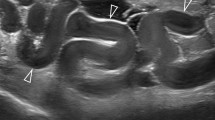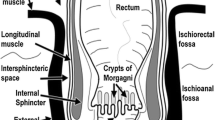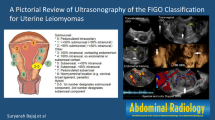Abstract
Introduction and hypothesis
Levator avulsion is a risk factor for female pelvic organ prolapse (POP) and recurrence after POP surgery. Imaging diagnosis requires the observation of an abnormal muscle insertion on tomographic ultrasound imaging (TUI). This study was designed to compare the diagnostic performance of the qualitative diagnosis (visual qualitative assessment) to measurement of the distance between muscle insertion and urethra [levator–urethra gap; (LUG)].
Methods
This was a retrospective analysis of data obtained in a tertiary urogynecological unit. All patients presented with symptoms of pelvic floor dysfunction and underwent 4D translabial pelvic floor ultrasound (US), supine, and after voiding. Avulsion was defined qualitatively as abnormal muscle insertion and quantitatively as LUG ≥25 mm on at least three consecutive central axial plane slices, with one examiner using both methods. We examined the correlation between both methods and validated them against clinical prolapse, significant organ descent on US, and hiatal ballooning.
Results
Between January and July 2013, 233 patients were seen, of whom 202 had complete volume data sets. The qualitative method diagnosed avulsion in 22 % and the quantitative method in 24.3 %. Agreement was good, with a kappa of 0.79 (0.70–0.87). Avulsion diagnosed by either method was associated with clinical and sonographic prolapse and hiatal ballooning, with odds ratios nonsignificantly higher for the quantitative method.
Conclusion
Qualitative analysis of slices on TUI and a method using LUG measurement show good agreement for the diagnosis of avulsion. The LUG method is at least equally as valid in its capacity to predict significant prolapse on clinical examination and US, as well as ballooning of the levator hiatus.

Similar content being viewed by others
References
Dietz H (2013) Pelvic floor trauma in childbirth. Aust NZ J Obstet Gynaecol 53:220–230
Dietz HP, Shek KL (2008) Validity and reproducibility of the digital detection of levator trauma. Int Urogynecol J 19:1097–1101
Kearney R, Miller JM, Delancey JO (2006) Interrater reliability and physical examination of the pubovisceral portion of the levator ani muscle, validity comparisons using MR imaging. Neurourol Urodyn 25(1):50–54
Dietz HP (2004) Ultrasound imaging of the pelvic floor. Part I: two-dimensional aspects. [Review] [86 refs]. Ultrasound Obstet Gynecol 23(1):80–92
DeLancey J, Morgan D, Fenner D, Kearney R, Guire K, Miller J et al (2007) Comparison of levator ani muscle defects and function in women with and without pelvic organ prolapse. Obstet Gynecol 109(2):295–302
Dietz HP, Hyland G, Hay-Smith J (2006) The assessment of levator trauma: a comparison between palpation and 4D pelvic floor ultrasound. Neurourol Urodyn 25(5):424–427
Kamisan Atan, I. Lin S, Herbison P, Wilson PD, Dietz HP. Assessment of levator avulsion: digital palpation versus tomographic ultrasound imaging. Abstract, IUGA 2015, Nice.
Zhuang R, Song Y, Chen Q, Ma M, Huang H, Chen J et al (2011) Levator avulsion using a tomographic ultrasound and magnetic resonance–based model. Am J Obstet Gynecol 205:232, e1-8
Dietz H (2007) Quantification of major morphological abnormalities of the levator ani. Ultrasound Obstet Gynecol 29:329–334
Dietz H, Bernardo M, Kirby A, Shek K (2011) Minimal criteria for the diagnosis of avulsion of the puborectalis muscle by tomographic ultrasound. Int Urogynecol J 22(6):699–704
Pattillo A, Guzman Rojas R, Dietz H (2014) Diagnosis of levator avulsion: is it necessary to perform tomographic imaging on pelvic floor muscle contraction? Neurourol Urodyn 33:1057–58
van Delft K, Thakar R, Sultan A, Kluivers B (2015) Does the prevalence of levator ani muscle avulsion differ when assessed using tomographic ultrasound imaging at rest vs on maximum pelvic floor muscle contraction? Ultrasound Obstet Gynecol 46(1):99–103
Dietz H, Abbu A, Shek K (2008) The levator urethral gap measurement: a more objective means of determining levator avulsion? Ultrasound Obstet Gynecol 32:941–945
Bump RC, Mattiasson A, Bo K, Brubaker LP, DeLancey JO, Klarskov P et al (1996) The standardization of terminology of female pelvic organ prolapse and pelvic floor dysfunction. Am J Obstet Gynecol 175(1):10–17
Kashihara H, Shek K, Dietz H (2012) Can we identify the limits of the puborectalis/ pubovisceralis muscle on tomographic translabial ultrasound? Ultrasound Obstet Gynecol 40(2):219–222
Dietz H, Mann K (2014) What is clinically relevant prolapse? an attempt at defining cutoffs for the clinical assessment of pelvic organ descent. Int Urogynecol J 25:451–455
Dietz HP, Haylen BT, Broome J (2001) Ultrasound in the quantification of female pelvic organ prolapse. Ultrasound Obstet Gynecol 18(5):511–514
Dietz HP, Lekskulchai O (2007) Ultrasound assessment of prolapse: the relationship between prolapse severity and symptoms. Ultrasound Obstet Gynecol 29:688–691
Shek, K. and H. Dietz, What is abnormal uterine descent on translabial ultrasound? Int Urogynecol J, 2015. in print.
Dietz H, De Leon J, Shek K (2008) Ballooning of the levator hiatus. Ultrasound Obstet Gynecol 31:676–680
Singh K, Jakab M, Reid W, Berger LA, Hoyte L (2003) Three-dimensional magnetic resonance imaging assessment of levator ani morphologic features in different grades of prolapse. Am J Obstet Gynecol 188(4):910–915
Hoyte L, Thomas JM, Foster RT, Shott S, Jakab M, Weidner AC (2005) Racial differences in pelvic morphology among asymptomatic nulliparous women as seen on three-dimensional magnetic resonance images. Am J Obstet Gynecol 193:2035–2040
Hoyte L, Schierlitz L, Zou K, Flesh G, Fielding JR (2001) Two- and 3-dimensional MRI comparison of levator ani structure, volume, and integrity in women with stress incontinence and prolapse. Am J Obstet Gynecol 185(1):11–19
Ismail S, Shek K, Dietz H (2010) Unilateral coronal diameters of the levator hiatus: baseline data for the automated detection of avulsion of the levator ani muscle. Ultrasound Obstet Gynecol 36:375–378, 2010(35): p. 2010
Shek K, Wong V, Krause H, Goh J, Dietz H (2013) Pelvic organ support in nulliparous Africans and Caucasians: a comparative study using 4D pelvic floor ultrasound. Ultrasound Obstet Gynecol 43(S1):99
Author information
Authors and Affiliations
Corresponding author
Ethics declarations
Conflicts of interest
None.
Rights and permissions
About this article
Cite this article
Dietz, H.P., Garnham, A.P. & Rojas, R.G. Is the levator–urethra gap helpful for diagnosing avulsion?. Int Urogynecol J 27, 909–913 (2016). https://doi.org/10.1007/s00192-015-2909-0
Received:
Accepted:
Published:
Issue Date:
DOI: https://doi.org/10.1007/s00192-015-2909-0




